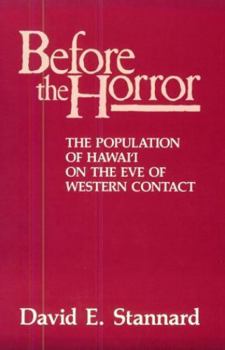Before the Horror: The Population of Hawai'i on the Eve of Western Contact
No Synopsis Available.
Format:Paperback
Language:English
ISBN:0824812328
ISBN13:9780824812324
Release Date:January 1989
Publisher:University of Hawaii Press
Length:149 Pages
Weight:0.55 lbs.
Customer Reviews
2 ratings
Ecological assessment versus "headcount"
Published by Thriftbooks.com User , 17 years ago
There is no doubt that the population of the (now) Hawaiian Islands was greater prior to European contact than after 1778. Smallpox, measles, tuberculosis, venereal diseases and many other biological maladies wreaked havoc on the Hawaiian population. The question is, what exactly WAS the population before Captain Cook showed up? Official estimates of Hawaiian demographers, after careful review of eyewitness accounts and reading the journals of visitors to the islands over the next 50 years, resulted in an estimate of, on average, about 200,000. David E. Stannard begs to disagree. In Before the Horror: The Population of Hawaii on the Eve of Western Contact, Stannard goes through a very interesting exercise. He makes ecological predictions of population levels. Given, say, 600 years of population growth from the original colonists, what COULD the population be? He calculates it in three ways: * simple population growth based on fertility and demographics, * using a rough energetic model, what population COULD the islands support, and * if the islands were "full," with the density based on productivity and eyewitness accounts, what might the population have been? Stannard computes a very different figure: 800,000 to a million pre-contact souls. He allows defenders of the 200,000 figure to critique his thesis. The critiques are very weak. "Oh yeah? Well what do you know?" I found Stannard's logic very persuasive. But so what? Contact happened, and the Hawaiian population responded negatively. Stannard's revised estimates are significant for at least two reasons. First, the "horror" was much, much worse than otherwise believed. The catastrophe was... catastrophic. Just think what would happen today with a 90% population reduction in 50 years. Second (and this is my own thought), apart from the numbers themselves, the social upheaval must have been tremendous. Whole segments of society disappeared forever. I've always wondered why there are so very few references in Hawaiian lore, tradition, and petroglyphs to whales, for example. Did all the whale specialists in Hawaiian society die, along with their oral traditions? What else was lost? If you are interested in Hawaii and Hawaiiana, then I encourage you to read Stannard's book.
Very Interesting Perspective, but......
Published by Thriftbooks.com User , 20 years ago
Stannard makes an argument for the Pre-Western Contact (1778) Native Hawaiian population in Hawaii reaching up to 1 million. The current total (all ethnicities)population in Hawaii is 1.2 million in 2000. He makes many logical and common sense arguments that justify his conclusions. Unfortunately, he also makes some very weak arguments. He does has some critical appraisal of his own arguments. His utilization of Schmitt and Nordyke, who are demographic authorities in Hawaii, as guest authors was very smart. However, they both basically do not agree with him so he criticizes them (they lean closer to 300-400,000) in an unprofessional manner. His criticisms seem emotional and over the top to me, and I was surprised it was not edited. Although I am open to the fact that his estimates may be right, the book is lessened academically by his crude criticisms of known authorities on the subject. If he was trying to create controversy, then he succeeded. Still, it is an enlightening historical read on the subject and the "outbursts" gave me a few chuckles.





